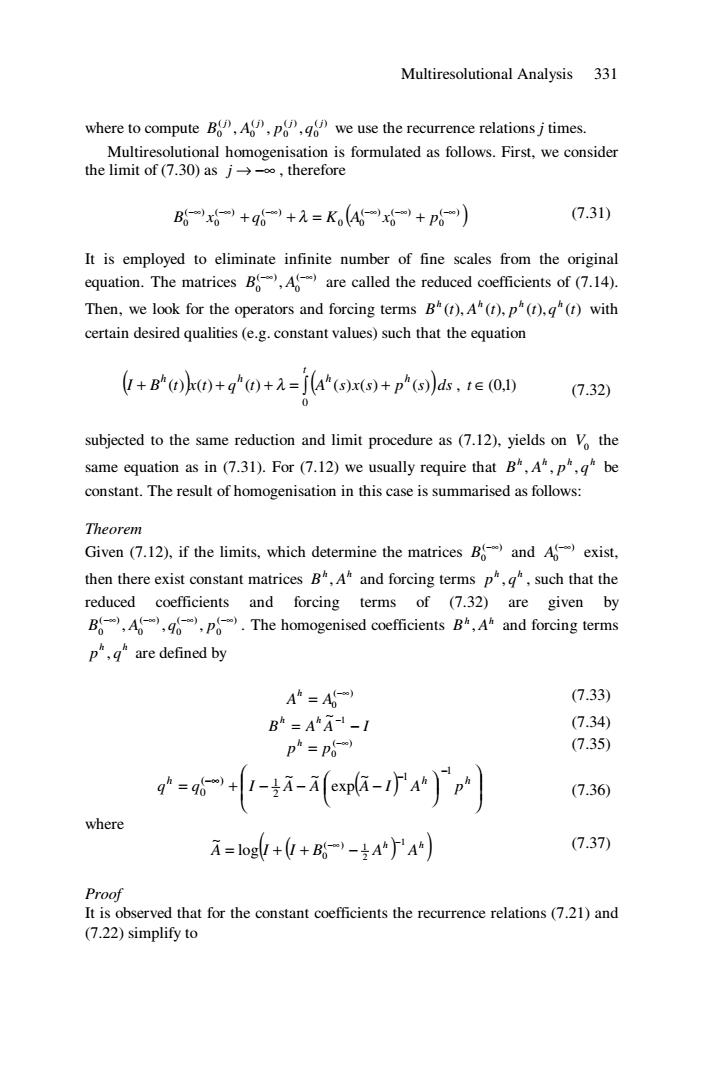正在加载图片...

Multiresolutional Analysis 331 where to compute B,Ap we use the recurrence relations jtimes. Multiresolutional homogenisation is formulated as follows.First,we consider the limit of (7.30)as j,therefore B6x6}+q6+元=K46x6+p) (7.31) It is employed to eliminate infinite number of fine scales from the original equation.The matrices BA are called the reduced coefficients of (7.14). Then,we look for the operators and forcing terms B"(t),A"(t),p"(t),g"(t)with certain desired qualities(e.g.constant values)such that the equation k()+q")+=f(A"(s)x(s)+p"(s))ds.tE(O.D) (7.32) subjected to the same reduction and limit procedure as (7.12),yields on V the same equation as in (7.31).For (7.12)we usually require that B",A",p""be constant.The result of homogenisation in this case is summarised as follows: Theorem Given(7.12),if the limits,which determine the matrices B and A exist, then there exist constant matrices B,A and forcing terms p",",such that the reduced coefficients and forcing terms of (7.32)are given by BAp.The homogenised coefficients B".A"and forcing terms p",q"are defined by A=A (7.33) B=AA-1-1 (7.34) p*=p (7.35) =6--i-广p (7.36) where A=1og+(0+B6)-AA (7.37) Proof It is observed that for the constant coefficients the recurrence relations (7.21)and (7.22)simplify toMultiresolutional Analysis 331 where to compute ( ) 0 ( ) 0 ( ) 0 ( ) 0 , , , j j j j B A p q we use the recurrence relations j times. Multiresolutional homogenisation is formulated as follows. First, we consider the limit of (7.30) as j → −∞ , therefore ( ) ( ) 0 ( ) 0 ( ) 0 0 ( ) 0 ( ) 0 ( ) 0 −∞ −∞ −∞ −∞ −∞ −∞ B x + q + λ = K A x + p (7.31) It is employed to eliminate infinite number of fine scales from the original equation. The matrices ( ) 0 ( ) 0 , −∞ −∞ B A are called the reduced coefficients of (7.14). Then, we look for the operators and forcing terms ) B (t), A (t), p (t), q (t h h h h with certain desired qualities (e.g. constant values) such that the equation () ( ) + + + = ∫ + t h h h h I B t x t q t A s x s p s ds 0 ( ) ( ) ( ) λ ( ) ( ) ( ) , ) t ∈ (0,1 (7.32) subjected to the same reduction and limit procedure as (7.12), yields on V0 the same equation as in (7.31). For (7.12) we usually require that h h h h B , be A , p , q constant. The result of homogenisation in this case is summarised as follows: Theorem Given (7.12), if the limits, which determine the matrices ( ) 0 −∞ B and ( ) 0 −∞ A exist, then there exist constant matrices h h B , and forcing terms A h h p , , such that the q reduced coefficients and forcing terms of (7.32) are given by ( ) 0 ( ) 0 ( ) 0 ( ) 0 , , , −∞ −∞ −∞ −∞ B A q p . The homogenised coefficients h h B , and forcing terms A h h p , are defined by q ( ) 0 −∞ A = A h (7.33) B A A I h h = − ~ −1 (7.34) ( ) 0 −∞ p = p h (7.35) ( ) ⎟ ⎟ ⎠ ⎞ ⎜ ⎜ ⎝ ⎛ ⎟ ⎠ ⎞ ⎜ ⎝ ⎛ = + − − − − − h −∞ h h q q I A A A I A p 1 1 2 ( ) 1 0 ~ exp ~ ~ (7.36) where ( ( ) ) h h A I I B A A 1 2 ( ) 1 0 log ~ − −∞ = + + − (7.37) Proof It is observed that for the constant coefficients the recurrence relations (7.21) and (7.22) simplify to